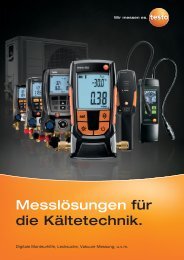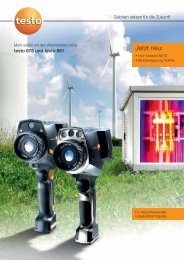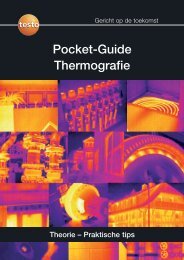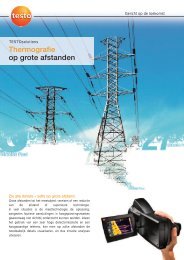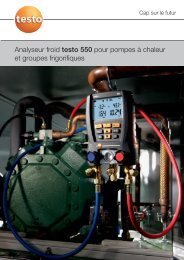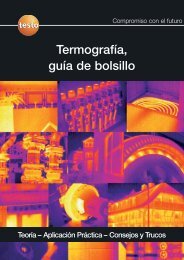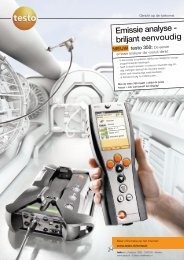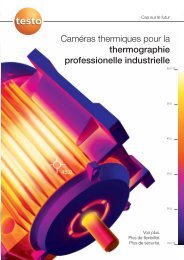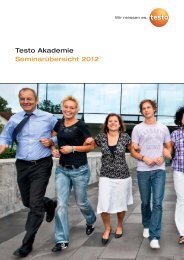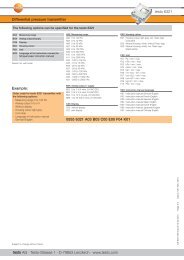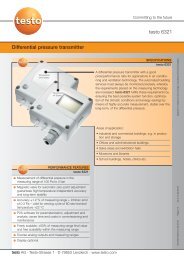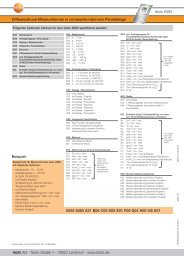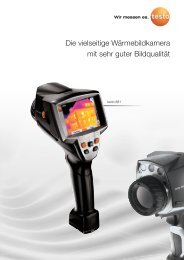Measurement Engineering for Air Conditioning and ... - Bad Request
Measurement Engineering for Air Conditioning and ... - Bad Request
Measurement Engineering for Air Conditioning and ... - Bad Request
Create successful ePaper yourself
Turn your PDF publications into a flip-book with our unique Google optimized e-Paper software.
Convenient material moisture equilibrium measurement with testo 635-2<br />
The moisture of materials can be<br />
determined with the testo 635<br />
using two different measurement<br />
principles.<br />
Surface measurement<br />
In surface measurement, the<br />
influence of water on electrical<br />
fields is exploited. With the help<br />
of the capacitive measurement<br />
principle, the material moisture is<br />
determined by the strength of the<br />
scatter field measured. The testo<br />
scatter field probe provides the<br />
benefits of non-destructive <strong>and</strong><br />
fast measurement on the outer<br />
surface of objects, reaching up to<br />
5 cm into the material. Testing<br />
large areas is thus childsplay, <strong>and</strong><br />
in combination with the memory<br />
function of the testo 635, quickly<br />
gives the user an overview.<br />
Detecting extremely damp spots<br />
<strong>and</strong> creating moisture maps can<br />
be carried out quickly, easily <strong>and</strong><br />
frequently.<br />
Depth measurement<br />
Hygroscopic materials (those<br />
which absorb moisture) always<br />
try to create a moisture balance,<br />
the so-called equilibrium<br />
moisture, with the surrounding<br />
air. By measuring the equilibrium<br />
moisture, this behaviour allows<br />
conclusions to be drawn about<br />
the material moisture.<br />
The measurement is ideally taken<br />
in a drill hole in the material. In<br />
order to keep the hole as small<br />
as possible, a humidity probe<br />
with a width of 4 mm <strong>and</strong> a<br />
protective cap is ideal. An<br />
adhesive putty is used to seal the<br />
drill hole. The measurement<br />
allows the spot measurement of<br />
material moisture at greater<br />
depths.<br />
Material characteristics curves <strong>for</strong><br />
the following materials are stored<br />
in the instrument <strong>for</strong> the<br />
calculation <strong>and</strong> display in percent<br />
by weight [%] <strong>for</strong> both<br />
measurement principles:<br />
• Soft wood<br />
• Hard wood<br />
• Chipboard<br />
• Insulating (vertically per<strong>for</strong>ated)<br />
brick<br />
• Solid brick<br />
• Aerated concrete<br />
• S<strong>and</strong>-lime brick<br />
• Calcium sulphate screed<br />
• Cement screed<br />
• Concrete<br />
The materials can be easily<br />
selected in the menu. When<br />
using the user profile "Material",<br />
the material can be selected<br />
directly with the press of a<br />
button.<br />
Determining screed moisture quickly <strong>and</strong> easily. Measuring several points over a<br />
surface with the scatter field probe ensures better security of measurement.<br />
Inserting the humidity probe in a bore hole with PTFE protective cap<br />
Convenient material moisture equilibrium measurement with<br />
testo 635-2<br />
testo 635-2, humidity/temperature measuring instrument with readings memory,<br />
PC software <strong>and</strong> USB data transmission cable, with battery <strong>and</strong> calibration<br />
protocol<br />
Scatter field probe <strong>for</strong> fast <strong>and</strong> damage-free material moisture measurement, with<br />
probe cable 1.2 m.<br />
Thin humidity probe with built-in electronics, incl. 4 attachable PTFE protection<br />
caps <strong>for</strong> material moisture equilibrium measurement<br />
0563 6352<br />
0636 6160<br />
0636 2135<br />
Adhesive material <strong>for</strong> fixing <strong>and</strong> sealing 0554 0761<br />
31



